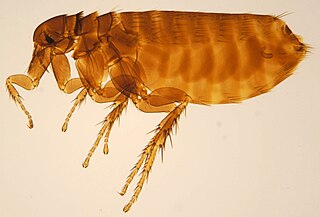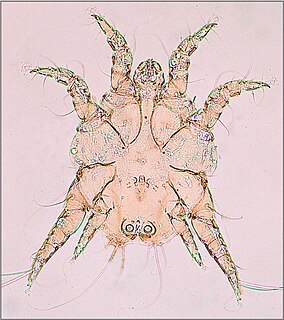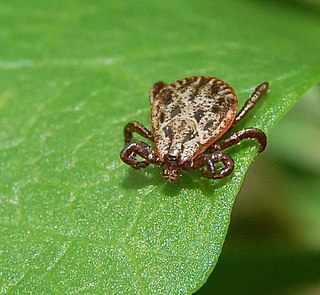
Flea, the common name for the order Siphonaptera, includes 2,500 species of small flightless insects that survive as external parasites of mammals and birds. Fleas live by consuming blood, or hematophagy, from their hosts. Adult fleas grow to about 3 millimetres long, are usually brown, and have bodies that are "flattened" sideways or narrow, enabling them to move through their host's fur or feathers. They lack wings, but have strong claws preventing them from being dislodged, mouthparts adapted for piercing skin and sucking blood, and hind legs extremely well adapted for jumping. They are able to leap a distance of some 50 times their body length, a feat second only to jumps made by another group of insects, the superfamily of froghoppers. Flea larvae are worm-like with no limbs; they have chewing mouthparts and feed on organic debris left on their host's skin.
Stephanocircidae is a family of fleas native to South America and Australia, where they are found on rodents.

Dame Miriam Louisa Rothschild was a British natural scientist and author with contributions to zoology, entomology, and botany.

Taenia pisiformis, commonly called the rabbit tapeworm, is an endoparasitic tapeworm which causes infection in lagomorphs, rodents, and carnivores. Adult T. pisiformis typically occur within the small intestines of the definitive hosts, the carnivores. Lagomorphs, the intermediate hosts, are infected by fecal contamination of grasses and other food sources by the definitive hosts. The larval stage is often referred to as Cysticercus pisiformis and is found on the livers and peritoneal cavities of the intermediate hosts. T. pisiformis can be found worldwide.

The Oriental rat flea, also known as the tropical rat flea, is a parasite of rodents, primarily of the genus Rattus, and is a primary vector for bubonic plague and murine typhus. This occurs when a flea that has fed on an infected rodent bites a human, although this flea can live on any warm blooded mammal.

Battus polydamas, also known as the gold rim swallowtail, the Polydamas swallowtail or the tailless swallowtail, is a species of butterfly in the family Papilionidae. The species was first described by Carl Linnaeus in his 10th edition of Systema Naturae, published in 1758.

Echidnophaga gallinacea, also known as the hen flea or sticktight flea, is part of the 2,500 known flea types in the Siphonaptera order. Echidnophaga gallinacea appear dark brown in colour and is a small flea measuring approximately 2 millimetres in length, which is half the size of the common cat flea. Echidnophaga gallinacea also differ in anatomy compared to the cat flea due to lacking genal and pronotal combs known as ctenidia. Echidnophaga gallinacea like all fleas, have powerful hind legs which allow the flea to jump great distances compared to its size.

Ceratophyllus gallinae, known as the hen flea in Europe or the European chicken flea elsewhere, is an ectoparasite of birds. This flea was first described by the German botanist and entomologist Franz von Paula Schrank in 1803.
Hepatocystis taiwanensis is a species of parasitic protozoa. They are transmitted by flies of the genus Culicoides and infect monkeys.

Pulex is a genus of fleas. It comprises seven species. One is the human flea, and five of the others are confined to the Nearctic and Neotropical realms.
George Henry Evans Hopkins OBE was an English entomologist.
Paramphistomum is a genus of parasitic flatworms belonging to the digenetic trematodes. It includes flukes which are mostly parasitising livestock ruminants, as well as some wild mammals. They are responsible for the serious disease called paramphistomiasis, also known as amphistomosis, especially in cattle and sheep. Its symptoms include profuse diarrhoea, anaemia, lethargy, and often result in death if untreated. They are found throughout the world, and most abundantly in livestock farming regions such as Australia, Asia, Africa, Eastern Europe, and Russia.
Spilopsyllus cuniculi, the rabbit flea, is a species of flea in the family Pulicidae. It is an external parasite of rabbits and hares and is occasionally found on cats and dogs and also certain seabirds that nest in burrows. It can act as a vector for the virus that causes the rabbit disease myxomatosis.

Mites that infest and parasitize domestic animals cause disease and loss of production. Mites are small invertebrates, most of which are free living but some are parasitic. Mites are similar to ticks and both comprise the order Acari in the phylum Arthropoda. Mites are highly varied and their classification is complex; a simple grouping is used in this introductory article. Vernacular terms to describe diseases caused by mites include scab, mange, and scabies. Mites and ticks have substantially different biology from, and are classed separately from, insects. Mites of domestic animals cause important types of skin disease, and some mites infest other organs. Diagnosis of mite infestations can be difficult because of the small size of most mites, but understanding how mites are adapted to feed within the structure of the skin is useful.
Maurice Neveu-Lemaire was a French physician and parasitologist.

Ceratophyllus is a widespread genus of fleas found in temperate climates. Some of its members include the chicken flea, Ceratophyllus gallinae, and the poultry flea, Ceratophyllus niger.
The hedgehog flea is a flea species which, as indicated by its common name, is an external parasite specifically adapted to living with the European hedgehog and the North African hedgehog, but it has also been found on other animals.
Echidnophaga myrmecobii is a stickfast flea that is native to Australia, and is commonly found on marsupials and rabbits. It is also found on European hares, cats, and dogs.

Dermacentor reticulatus, also known as the ornate cow tick, ornate dog tick, meadow tick, and marsh tick, is a species of tick from the family Ixodidae. It is the type species for the genus Dermacentor. D. reticulatus is an ornate tick. The female varies in size from 3.8–4.2 mm (unfed) to 10 mm when engorged after feeding. The unfed male is 4.2–4.8 mm long. D. reticulatus is found in Europe and Western Asia, generally in wooded areas.
Hectopsylla is a genus of fleas in the family Hectopsyllidae that parasitize non-volant mammals, birds, and bats. The genus comprises thirteen species, six of which were described in whole or part by Karl Jordan between 1906–1942. Two of the species in Hectopsylla, H. psittaci and H. pulex, go under common names, with H. psittaci identified as the sticktight flea and H. pulex identified as the chiggerflea. Hastritter and Méndez (2000) consider the genus Rhynchopsyllus a junior system of the genus.










